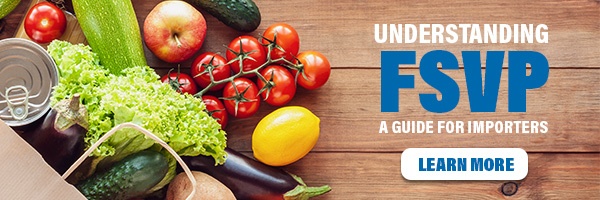.jpg?width=600&name=how-to-implement-an-fsvp-plan%20(1).jpg)
An FDA ruling put in place in 2017 seeks to ensure that all countries meet minimum food safety requirements to prevent foodborne illness.We can distill the purpose of the Final Rule on Foreign Supplier Verification Programs (FSVP) down to a single principle: foreign food companies must meet the standards of the Food Safety Modernization Act (FSMA). The new law shifts the burden of keeping imported food safe for consumption onto importers. The regulation requires U.S. food importers to develop, maintain, and follow an FSVP Plan for every food-type and every foreign supplier of that food.
What is an FSVP Plan?
An FSVP Plan is a program importers put in place to verify their foreign suppliers produce food in a manner that protects public health. The plans prove foreign suppliers export unadulterated food, identify allergens, and meet U.S. preventive controls or provide safety regulations.
Food covered in an FSVP Plan includes all ingredients in food and beverages, food and color additives introduced during processing, dietary supplements, packaging, and food contact substances.
There are partial and minor exceptions to the FSVP rule. Food regulated by the United States Department of Agriculture (USDA) or Hazard Analysis and Critical Control Point (HACCP)—such as meat, poultry, and egg products—is not subject to FSVP regulations. For foods that fall under FSVP rules, companies must have a written program—preferably vetted by a third party—that explains their supplier verification process. A written FSVP Plan helps the FDA understand an importer’s approach to verification.

Who Should Develop an FSVP?
The law requires a qualified individual (QI) to develop an importer’s FSVP Plan and perform FSVP activities. The importer’s QI must have the knowledge, skills, and abilities needed to test foreign supplier compliance. This know-how can come from education, on-the-job experience, or both.
A QI can be someone on staff, or importers can rely on a consultant or third-party auditor. A government employee, including one from a foreign government, can also qualify. A Preventive Controls Qualified Individual (PCQI) fits the bill, too. These professionals already meet current good manufacturing practices (cGMP) and preventive control rules, which are more stringent than FSVP QI requirements.
The QI fills an important role, no matter the route an importer takes. They perform seven key steps to develop an FSVP Plan for every foreign supplier and all food imported from those suppliers.
Step 1: Review Compliance Status
The QI first reaches out to a foreign supplier to review their current compliance status. The QI also considers the supplier’s compliance history by examining Customs warning letters, import alerts, and requirements for certification issued by the FDA under section 801(q) of the Food, Drug, and Cosmetic Act (FD&C Act).
Step 2: Perform Hazard Analysis
Importers must check the potential hazards associated with each imported food, including the likelihood and severity of the hazard if it were to occur. Most times, a foreign supplier has already performed a hazard analysis. In these situations, the QI looks over and documents his or her review of the existing hazard analysis.
If a supplier lacks a hazard analysis, importers assume responsibility for examining the company’s operations and looking for hazards requiring control. If the review does not identify any risks, it eliminates the need for product verification. However, an importer should keep the hazard analysis on file as proof.
Step 3: Verify Suppliers
Importers can verify suppliers through a variety of methods. Verification measures can include on-site audits, periodic sampling and testing, and review of foreign supplier food safety records and documentation.
On-site Audit: Importers can conduct their own on-site audits or hire a third-party auditor to examine a foreign supplier’s operations and review the results. Importers do not need on-site audits unless there is a reasonable probability that a hazard may cause serious adverse health consequences or death, according to the Code of Federal Regulations (CFR) Title 21.
Sampling and Testing of Food: If an importer relies on product testing and sampling for verification, they must keep specific information about the sampling and testing process. They need to maintain records about:
- The number of and types of samples tested
- The lot numbers of the samples tested
- The tests conducted
- Corrective actions taken for detected hazards
- Information about the testing laboratory
- Documentation showing a QI performed the tests
Review of Food Safety Records: Importers can review a foreign supplier’s food safety records for verification. If so, they must keep information about the records they reviewed, the dates of their reviews, and the nature of the records they examined. They must also maintain records of their findings and the corrective actions taken in response to identified deficiencies.
Step 4: Take Corrective Action
Importers can require corrective actions of their suppliers when warranted. Verification activities may find a company is not keeping a product at a specific temperature to avoid spoiling, or that a company is harvesting lettuce after spreading organic manure. The review may find a company needs to install restrooms for field workers. Each of these examples requires a specific corrective action showing that remedies will differ for every company and every product.
Step 5: Provide Importer Identification Upon Entry
All importers need a Data Universal Numbering System (DUNS) number for their company. Importers should provide their name and DUNS number when filing for entry with Customs and Border Protection.
Step 6: Keep Thorough Records
Keeping copious records is also critical. Under the FSVP rule, the FDA requires that importers maintain records related to compliance status, foreign supplier verification activities, hazard analyses, investigations, corrective actions, and FSVP reassessments.
Importers must keep original copies of their records, photocopies, or digital records for at least two years unless otherwise specified. In addition, the documents must be available to the FDA upon request.
Related Content: How to Plan an SOP for Freight Forwarding
Step 7: Periodically Reassess the FSVP Plan
Once verification is complete, an importer can source products from an approved supplier. However, a successful FSVP plan requires ongoing review and maintenance. The law stipulates that importers reassess their FSVP Plans every three years. If at any time an importer learns of new hazards with imported products, such as a new source of raw materials or a different product formulation, a review must occur sooner.
If the review finds an imported food no longer meets FSVP requirements, importers must take corrective action. Their steps could include not working with a supplier until they address identified hazards or electing to update their FSVP Plan to ensure they vet suppliers more thoroughly.
The purpose of the FSVP to ensure importers do their due diligence before importing food into the United States. Taking a proactive approach to compliance prevents problems down the road. Should the FDA find a company’s FSVP efforts lacking, it can stop shipments from entering the country—even if the food is safe and the foreign supplier is complying. By sharpening their FSVP Plans, importers can protect themselves while also safeguarding the US food supply.



